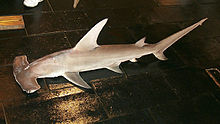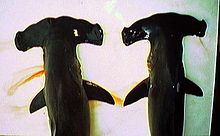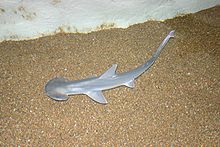Hammerhead shark
![]()
Hammerhead is a redirect to this article. For the band see Hammerhead (band).
The hammerhead sharks (Sphyrnidae) are a family of sharks that are particularly characterized by the strong broadening of their head to a so-called cephalofoil; in some species this leads to the formation of the eponymous "hammer". The family comprises two genera with a total of eight species, which differ mainly in size and shape and width of the head. The largest species is the great hammerhead shark (Sphyrna mokarran) with a maximum length of 5.50 to 6.10 meters, while the corona hammerhead shark (Sphyrna corona), as the smallest species, only reaches a maximum total length of less than one meter.
Hammerhead sharks live mainly in tropical and subtropical coastal areas worldwide. They are usually solitary, although some species can form groups of several hundred to several thousand individuals. As hunters, they prey on a variety of invertebrates as well as bony and cartilaginous fish. Larger individuals also prey on other sharks, including smaller members of their own species (cannibalism). Especially bottom-dwelling prey such as various rays are detected by the sensory organs located on the cephalofoil. All hammerhead sharks are viviparous and produce a placenta for the mother's care of the young. The large species are considered potentially dangerous, but shark accidents involving hammerheads have been documented very rarely. Some species are commercially hunted mainly for their fins, and individual species are classified as "endangered" to "critically endangered" by the International Union for Conservation of Nature (IUCN) due to heavy fishing pressure.
Features
Hammerheads have a streamlined body. The longest known representative is the great hammerhead shark (Sphyrna mokarran) with a maximum total length of 5.50 to 6.10 meters, while the corona hammerhead shark as the smallest species only reaches a maximum of 92 centimeters. The coloration of the species is usually brownish to gray with a white belly, a marking is only present in the shovelnose hammerhead in the form of irregular spotting and in some species in the form of dark fin tips or edges. The golden-yellow to orange colouration of the small-eyed hammerhead shark is a special feature, which can probably be traced back to its main diet. In juveniles it consists of shrimps, which are rich in carotenoids, and in sexually mature sharks of fish and fish roe, which also contain these pigments.
Particularly striking is the strong broadening of the head directly in front of the gills (prebranchial); it is also strongly flattened in some species. The resulting head shape is the most important distinguishing feature of the species due to its species-typical development into a broadened to hammer-shaped head (cephalofoil). The widening of the head in the species of the genus Sphyrna is between 17 and 33 percent of the total length, in the winged hammerhead shark (Eusphyra blochii) even 40 to 50 percent. The eyes are located laterally at the end of the cephalofoil, are round or nearly round in shape, and have an internal nictitating membrane. The nostrils have short, lobed nasal valves; the distance between the nostrils at the leading edge of the cephalofoil is 7 to 14 times the nostril diameter; an exception is the winghead hammerhead with its very greatly enlarged nostrils, where the distance is only 1.1 to 1.3 times the nostril diameter. The mouth lies below the cephalofoil and is usually parabolic in shape. The labial grooves are only indistinctly developed or completely absent. The teeth in the upper and lower jaws of hammerhead sharks differ very little from each other: they are comparatively small to moderately large, are more or less blade-shaped in shape, and have only a narrow central apex with no secondary apices; basal ridges and furrows may be developed or absent. In the upper jaw there are 25 to 37 teeth on one half of the jaw and in the lower jaw 24 to 37 teeth, behind which there are further rows of teeth.
Hammerheads have five gill slits, the splash hole is reduced in all species. The first dorsal fin begins approximately midway between the pectoral and pelvic fins, in some species also closer to the end of the pectoral fins; the middle of the dorsal fin is always in front of the base of the pelvic fins. It is moderately to very large and sickle-shaped, the second dorsal fin and the anal fin are clearly smaller. Pits are present in front of the base of the caudal fin. It is asymmetrical with a very large upper and a much smaller, but also strongly developed lower lobus. The upper caudal lobe is always significantly larger than the first dorsal fin.
In addition to these external features, there are some characteristics of the cephalic skeleton and spine that are typical of hammerhead sharks. For example, the neurocranium does not have primary supraorbital ridges; instead, extensions of the pre- and post-orbital bones fuse to form secondary supraorbital ridges unique among sharks. The centers of the vertebral bodies form strong, wedge-shaped, and vertebrae-spanning calcifications.

Habitus of the Great Hammerhead

The cephalofoil of the scalloped hammerhead shark (left) and the smooth hammerhead shark (right) in comparison
Function of the head extension
The function and thus the evolutionary emergence and development of the cephalofoil of hammerhead sharks is not conclusively clarified. It is assumed, among other things, that the widening of the head mainly serves the better maneuverability of the shark, in addition, it increases its field of perception. The former also led to the name "Cephalofoil" ("head rudder surface"), which was derived from the English term "Airfoil" for wing profile in aircraft construction. In terms of function, the cephalofoil corresponds to the canard wing, which is used in aircraft construction and enables altitude control by means of additional airfoils on the nose of the aircraft. The main purpose is to improve maneuverability and lift in very tight turns. The additional buoyancy aid allows the pectoral fins to be relatively small compared to other sharks.
The eyes and the greatly enlarged nasal pits are located at the end of the broadening in these sharks, so that the field perceived by these sensory organs is greatly expanded. This also applies to the Lorenzinian ampullae found on the front of the cephalofoil, which in hammerhead sharks, in addition to electrical impulses of potential prey fish, possibly also perceive the earth's magnetic field and would thus serve as an orientation aid during the migrations that are typical for some hammerhead sharks.
In 2002, comparative mathematical modelling of the perception of electromagnetic fields by the Lorenzinian ampullae confirmed the optimised detection of prey by a hammerhead shark compared to a round-headed shark. While in other sharks, such as the blue shark (Prionace glauca), the perception channels of the Lorenzinian ampullae are essentially circularly aligned with a centre in the middle of the head, in a hammerhead shark they are centred on three centres. It was determined that this significantly improves both the intensity of perception and the directional mapping of electromagnetic fields caused by the potential prey animal. In 2009, McComb et al. were able to demonstrate experimentally that the particularly strong broadening of the head in the winghead hammerhead shark and the scalloped hammerhead shark also significantly improves visual perception. According to their studies, sharks with a wide cephalofoil have a significantly larger visual field as well as a likewise greatly enlarged overlapping area in which binocular and thus three-dimensional vision is possible.
Other hypotheses assume that the broad head serves to fix prey, especially stingrays and other rays, on the seabed, as has been observed especially in the Great Hammerhead. This was inferred in part from an observation of a Great Hammerhead shark preying on an American stingray (Dasyatis americana) in the Bahamas area. The shark first knocked the ray to the seabed with an attack from above, and then held it there with its broad head while it turned and bit each vigorously on both sides of its enlarged pectoral fins. The ray, thus immobilized, was lifted off with its mouth and dissected with rapid movements of the shark's head. In another sighting, a great hammerhead was observed attacking a spotted eagle ray (Aetobatus narinari) in open water by biting a large chunk out of one of its pectoral fins and then also pushing it head down to the bottom, where it took the ray head first into its mouth. Based on these observations, it is believed that when hunting rays, hammerhead sharks first try to incapacitate them with the first bite and then use the widened head to bring the prey under control and hold them on the bottom.

The very wide "hammer" of a Great Hammerhead Shark

North American XB-70 with canard wing

Shovelnose-hammer-sharks possess a comparatively weakly widened head.
Questions and Answers
Q: What is a Hammerhead shark?
A: Hammerhead shark refers to a group of sharks that belong to the family Sphyrnidae.
Q: What makes Hammerhead sharks different from other sharks?
A: The unique feature of Hammerhead sharks is their head which looks like a hammer.
Q: What is the Hammerhead shark's head called?
A: The Hammerhead shark's head is called the "cephalofoil".
Q: How many species of Hammerhead sharks are there?
A: There are nine species of Hammerhead sharks, with one species belonging to genus Eusphyra and the other eight belonging to genus Sphyrna.
Q: What is the name of the species of Hammerhead shark that belongs to genus Eusphyra?
A: Winghead shark is the name of the species of Hammerhead shark that belongs to genus Eusphyra.
Q: What are the other eight species of Hammerhead sharks called?
A: The other eight species of Hammerhead sharks are not identified by name in the given text.
Q: Do all Hammerhead sharks have the same shaped head?
A: No, the shape of their head varies slightly depending on the species.
Search within the encyclopedia